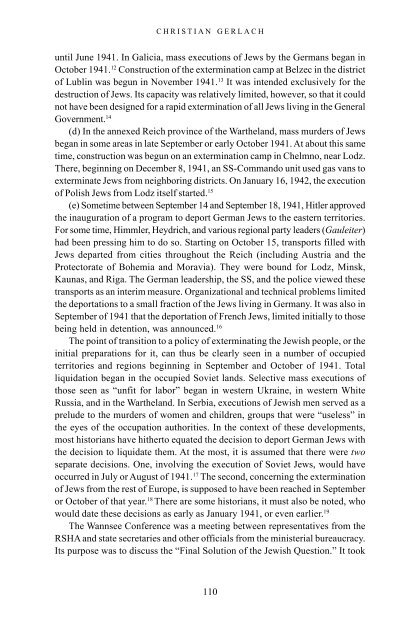The_Holokaust_-_origins,_implementation,_aftermath
The_Holokaust_-_origins,_implementation,_aftermath
The_Holokaust_-_origins,_implementation,_aftermath
You also want an ePaper? Increase the reach of your titles
YUMPU automatically turns print PDFs into web optimized ePapers that Google loves.
CHRISTIAN GERLACH<br />
until June 1941. In Galicia, mass executions of Jews by the Germans began in<br />
October 1941. 12 Construction of the extermination camp at Belzec in the district<br />
of Lublin was begun in November 1941. 13 It was intended exclusively for the<br />
destruction of Jews. Its capacity was relatively limited, however, so that it could<br />
not have been designed for a rapid extermination of all Jews living in the General<br />
Government. 14<br />
(d) In the annexed Reich province of the Wartheland, mass murders of Jews<br />
began in some areas in late September or early October 1941. At about this same<br />
time, construction was begun on an extermination camp in Chelmno, near Lodz.<br />
<strong>The</strong>re, beginning on December 8, 1941, an SS-Commando unit used gas vans to<br />
exterminate Jews from neighboring districts. On January 16, 1942, the execution<br />
of Polish Jews from Lodz itself started. 15<br />
(e) Sometime between September 14 and September 18, 1941, Hitler approved<br />
the inauguration of a program to deport German Jews to the eastern territories.<br />
For some time, Himmler, Heydrich, and various regional party leaders (Gauleiter)<br />
had been pressing him to do so. Starting on October 15, transports filled with<br />
Jews departed from cities throughout the Reich (including Austria and the<br />
Protectorate of Bohemia and Moravia). <strong>The</strong>y were bound for Lodz, Minsk,<br />
Kaunas, and Riga. <strong>The</strong> German leadership, the SS, and the police viewed these<br />
transports as an interim measure. Organizational and technical problems limited<br />
the deportations to a small fraction of the Jews living in Germany. It was also in<br />
September of 1941 that the deportation of French Jews, limited initially to those<br />
being held in detention, was announced. 16<br />
<strong>The</strong> point of transition to a policy of exterminating the Jewish people, or the<br />
initial preparations for it, can thus be clearly seen in a number of occupied<br />
territories and regions beginning in September and October of 1941. Total<br />
liquidation began in the occupied Soviet lands. Selective mass executions of<br />
those seen as “unfit for labor” began in western Ukraine, in western White<br />
Russia, and in the Wartheland. In Serbia, executions of Jewish men served as a<br />
prelude to the murders of women and children, groups that were “useless” in<br />
the eyes of the occupation authorities. In the context of these developments,<br />
most historians have hitherto equated the decision to deport German Jews with<br />
the decision to liquidate them. At the most, it is assumed that there were two<br />
separate decisions. One, involving the execution of Soviet Jews, would have<br />
occurred in July or August of 1941. 17 <strong>The</strong> second, concerning the extermination<br />
of Jews from the rest of Europe, is supposed to have been reached in September<br />
or October of that year. 18 <strong>The</strong>re are some historians, it must also be noted, who<br />
would date these decisions as early as January 1941, or even earlier. 19<br />
<strong>The</strong> Wannsee Conference was a meeting between representatives from the<br />
RSHA and state secretaries and other officials from the ministerial bureaucracy.<br />
Its purpose was to discuss the “Final Solution of the Jewish Question.” It took<br />
110



